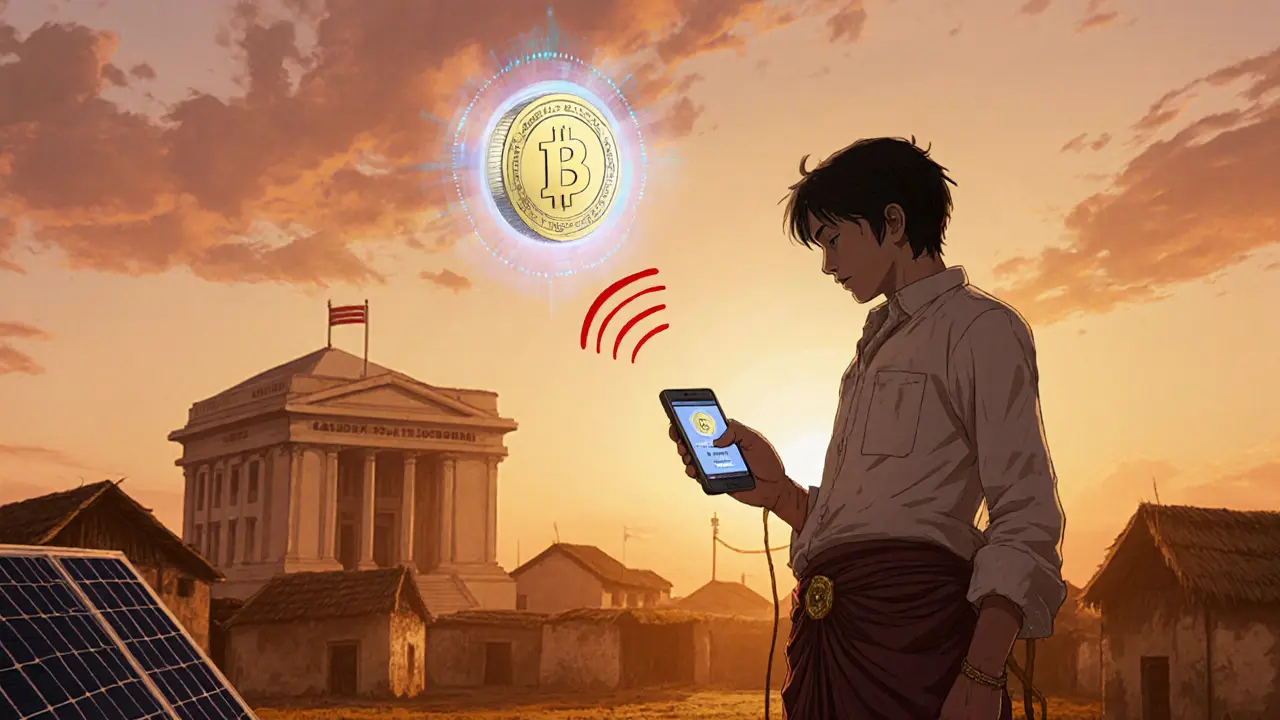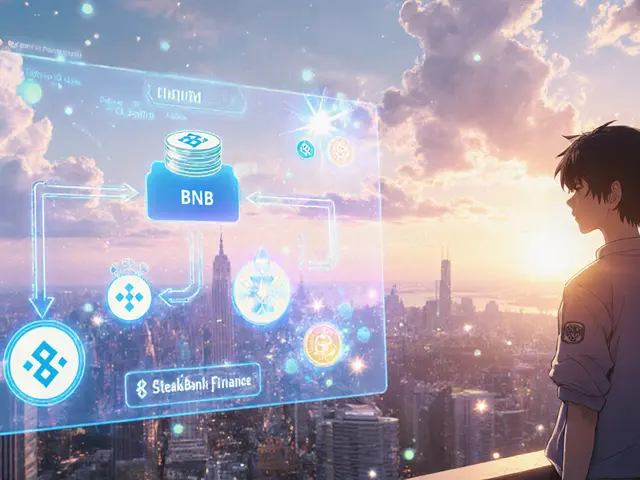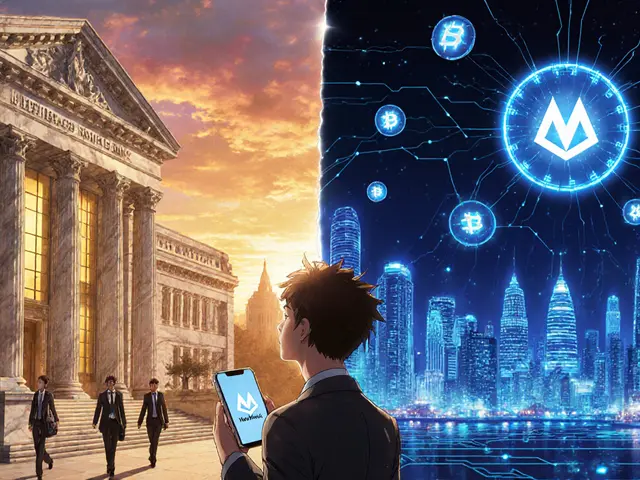DeFi vs TradFi Fee Calculator
Compare Transaction Costs
See how DeFi transaction fees compare to traditional banking fees. DeFi uses gas fees on blockchains like Ethereum, while traditional finance uses standard bank transfer fees.
When people talk about Decentralized Finance (DeFi) a blockchain‑based financial system that runs on smart contracts and removes banks, brokers, and other intermediaries, the reaction is usually a mix of excitement and caution. Why? Because DeFi promises 24/7 global access, near‑instant settlement, and lower fees - all things that traditional finance (often called Traditional Finance (TradFi) the legacy system of banks, clearinghouses, and regulated financial institutions struggles to deliver.
Why DeFi Exists: The Core Value Proposition
At its heart, DeFi is about permissionless participation. Anyone with an internet connection and a non‑custodial wallet can lend, borrow, trade, or earn yield without filling out KYC forms. The World Bank estimates that 1.7 billion adults lack access to basic banking services. DeFi’s open‑gate approach directly targets that gap.
Beyond inclusion, DeFi automates processes that TradFi handles manually. Smart contracts execute loan terms, price swaps, and collateral liquidation exactly as coded, wiping out the need for clerks, paperwork, and hours‑long settlement cycles. OSL’s 2025 study shows settlement times dropping from the typical T+2 or T+3 in equities to a few seconds on a blockchain.
Key Building Blocks
Understanding how DeFi works requires a look at its main components. The first is the underlying blockchain, and Ethereum the leading public blockchain that introduced Turing‑complete smart contracts in 2015 still dominates with about 58 % of total protocol value. However, high gas fees on congested Ethereum have pushed developers toward Layer 2 scaling solutions such as Polygon, Optimism, and Arbitrum that batch transactions off‑chain and settle them on the main chain, bringing fees down to pennies and boosting throughput to a few thousand transactions per second.
The second pillar is Smart contracts self‑executing code that runs on a blockchain and enforces agreements without intermediaries. They are the engine behind lending platforms like Aave, decentralized exchanges such as Uniswap, and stablecoins managed by MakerDAO.
Finally, user interaction happens through a non‑custodial wallet. MetaMask a browser extension that stores private keys locally and lets users sign blockchain transactions is the most widely adopted entry point, with a 3.8/5 rating on Trustpilot and over 850,000 active users on Ethereum’s Discord as of early 2025.
DeFi vs TradFi: A Side‑by‑Side Look
| Aspect | DeFi | TradFi |
|---|---|---|
| Custody | Self‑custody via wallets (e.g., MetaMask, Ledger) | Third‑party custody in banks or brokerages |
| Access | Permissionless, global 24/7 | Permissioned, business‑hour limited |
| Settlement | Instant (seconds) | Delayed (T+2 for equities, T+3 for bonds) |
| Fees | Low gas fees (often <$0.10 on L2) | Higher commissions, custody fees |
| Regulation | Emerging frameworks, partial KYC | Well‑established regulatory regime |
The table highlights why many users gravitate toward DeFi for speed and cost, while institutions still prefer TradFi for legal certainty and consumer protection.

Real‑World Use Cases that Show Disruption
A farmer in Bihar can now lock crypto collateral on Aave a DeFi lending protocol where users earn interest or borrow assets against crypto collateral and receive a loan in stablecoins without paperwork. In Southeast Asia, merchants accept payments on the Binance Smart Chain, converting them instantly to local fiat via on‑ramps that settle in seconds.
On the institutional side, JPMorgan’s Onyx blockchain handles $1 billion daily in wholesale payments, a clear signal that big banks are testing the same tech that powers DeFi. Tokenization projects are wrapping real‑estate, equities, and even art into ERC‑20 tokens, boosting liquidity by up to 60 % in pilot studies.
Challenges: Why DeFi Isn’t a Silver Bullet
Security remains the biggest concern. The Poly Network hack in 2021 siphoned $600 million, and although incident rates fell 37 % year‑over‑year after 2024, vulnerabilities still surface. Users must manage private keys, avoid phishing, and understand gas dynamics. According to a 2025 DeFi Pulse survey, 33 % of errors stem from mis‑configured transactions and 21 % from selecting the wrong network.
Scalability is another hurdle. Ethereum’s base layer processes 15‑30 TPS, far below Visa’s 24,000 TPS. Layer‑2 solutions improve this to 2,000‑4,000 TPS, but they add complexity. Moreover, the over‑collateralization requirement (often 150 % of the loan amount) means you need to lock more value than you borrow, which can deter users seeking leverage.
Regulatory uncertainty also slows adoption. In the U.S., 32 % of DeFi protocols restrict American users, while countries like Singapore and Switzerland provide clearer guidance. Tax treatment varies widely; India’s 30 % flat crypto tax plus 1 % TDS dampens participation among Indian users.
Emerging Trends Shaping the Future
Three convergence pathways are gaining traction:
- Interoperability protocols - Projects like Cosmos and Polkadot let assets move across chains, enabling TradFi systems to plug into DeFi liquidity pools without rewriting code.
- Asset tokenization - Real‑world assets are being minted as NFTs or ERC‑20 tokens, unlocking fractional ownership and opening new markets for investors.
- Decentralized identity - DeFAI the blend of DeFi and AI that uses smart‑agent avatars to guide users through complex transactions leverages AI to automate KYC, risk assessment, and portfolio rebalancing, making DeFi more user‑friendly.
Gartner predicts that by 2028, 20 % of traditional services will embed DeFi components. That doesn’t mean banks will disappear; rather, they will adopt hybrid models where the back‑end runs on blockchain while the front‑end stays familiar.

Getting Started: A Practical Checklist
- Download a trusted wallet (MetaMask or Ledger). Installation takes about 5 minutes.
- Buy a small amount of ETH or BNB on a regulated exchange.
- Connect your wallet to a reputable dApp (Uniswap for swapping, Aave for lending).
- Set slippage tolerance (2‑3 % is common) and double‑check the network.
- Start with a low‑risk activity, such as providing liquidity to a stable‑coin pool.
Expect to spend 15‑20 hours to feel comfortable with the basics. Community forums, Discord servers, and the official docs of each protocol are valuable resources, but remember that response times can be long and advice varies in quality.
Conclusion: A Balanced View
DeFi is undeniably shaking up the financial landscape. It offers speed, lower fees, and global access that TradFi struggles to match. At the same time, security, regulatory, and usability challenges keep it from fully replacing the old system today. The most realistic outlook sees both worlds co‑existing, with DeFi modules powering specific services while banks provide the safety net and consumer trust.
Frequently Asked Questions
What is the main advantage of DeFi over traditional banking?
DeFi lets anyone with an internet connection open a wallet, lend, borrow, or trade without asking for approval. Transactions settle in seconds and fees are often just a few cents, compared with days and higher costs in legacy banks.
Are DeFi platforms safe to use?
Safety depends on the protocol, code audits, and user practices. Major platforms have undergone multiple audits, but bugs still happen. Using hardware wallets, enabling two‑factor authentication, and starting with small amounts reduces risk.
How do I get started with DeFi?
Install a non‑custodial wallet like MetaMask, fund it with ETH or another supported token, and connect to a trusted dApp such as Uniswap or Aave. Follow the on‑screen prompts, set a reasonable slippage limit, and test with a tiny trade first.
Can I use DeFi in my country?
Regulations vary. Some jurisdictions restrict access to certain protocols, while others, like Singapore, encourage innovation. Always check local laws before moving large sums.
What does “over‑collateralization” mean?
It means you must lock more value than you borrow. For a $1,000 loan you might need $1,500 worth of crypto as collateral, protecting lenders from price volatility.



Marina Campenni
August 18, 2025 AT 23:32The breakdown of DeFi's benefits makes it clear why many people are drawn to it. Access without KYC, lower fees, and faster settlement can truly empower the unbanked. However, the security risks of smart contracts shouldn't be ignored.
Irish Mae Lariosa
August 26, 2025 AT 01:32While the article offers a decent overview, it glosses over several critical shortcomings that cannot be dismissed. First, the notion that DeFi fees are always lower fails to account for volatile gas prices on congested networks. Second, the security of smart contracts is not merely a minor inconvenience but a systemic vulnerability that has been exploited repeatedly. Third, the liquidity in many DeFi platforms remains shallow, leading to severe slippage during market stress. Fourth, regulatory uncertainty means users could face legal repercussions tomorrow without any warning. Fifth, the user experience is still far from mainstream banking standards, often requiring technical know-how. Sixth, the reliance on underlying blockchains introduces scalability constraints that layer‑2 solutions have not fully resolved. Seventh, the promised transparency is sometimes obfuscated by complex code that even seasoned developers struggle to audit. Eighth, the composability of protocols, while innovative, creates hidden interdependencies that can trigger cascading failures. Ninth, many projects lack robust governance frameworks, leaving token holders powerless during critical decisions. Tenth, the environmental impact of proof‑of‑work chains, despite shifts to proof‑of‑stake, still lingers in public perception. Eleventh, the narrative of financial inclusion often overlooks the digital divide, where internet access is scarce. Twelfth, the article omits the fact that some traditional finance institutions are already integrating blockchain technology, blurring the dichotomy. Thirteenth, the comparative table simplifies complex financial products into binary distinctions, which can be misleading. In summary, while DeFi offers exciting possibilities, a balanced assessment must include these substantial challenges.
Nick O'Connor
September 2, 2025 AT 03:32DeFi, as presented, offers unprecedented access, yet, it also demands a careful assessment, especially regarding security, liquidity, and regulatory compliance.
DeAnna Brown
September 9, 2025 AT 05:32Honestly, the US financial system could learn a thing or two from DeFi’s innovation – it’s time to catch up, folks!
Chris Morano
September 16, 2025 AT 07:32It's great to see more people exploring alternatives, and I hope we can find ways to bridge the gap between DeFi and traditional banks.
Carolyn Pritchett
September 23, 2025 AT 09:32This article completely ignores the massive hacks that have plagued DeFi – a glaring omission that makes its praise feel like propaganda.
lida norman
September 30, 2025 AT 11:32I really appreciate how the piece highlights the potential for financial freedom – it gives me hope! :)
Devi Jaga
October 7, 2025 AT 13:32Oh great, another glorified hype piece that pretends layer‑2 scaling solves everything while ignoring the underlying tokenomics decay.
Matthew Theuma
October 14, 2025 AT 15:32When you think about money as a social construct, defi feels like a natural evolution 🌌. Yet, we must stay vigilant about the perils of code‑only governance 🤔.
Jason Zila
October 21, 2025 AT 17:32DeFi's impact on emerging markets can't be overstated.
Cecilia Cecilia
October 28, 2025 AT 19:32The comparison table succinctly captures key differences between the two systems.
Jessica Cadis
November 4, 2025 AT 21:32From an American standpoint, embracing DeFi could reshape our financial landscape while preserving consumer protections.
Katharine Sipio
November 11, 2025 AT 23:32Let us continue to explore these innovations with optimism and rigor; the future of finance looks promising.